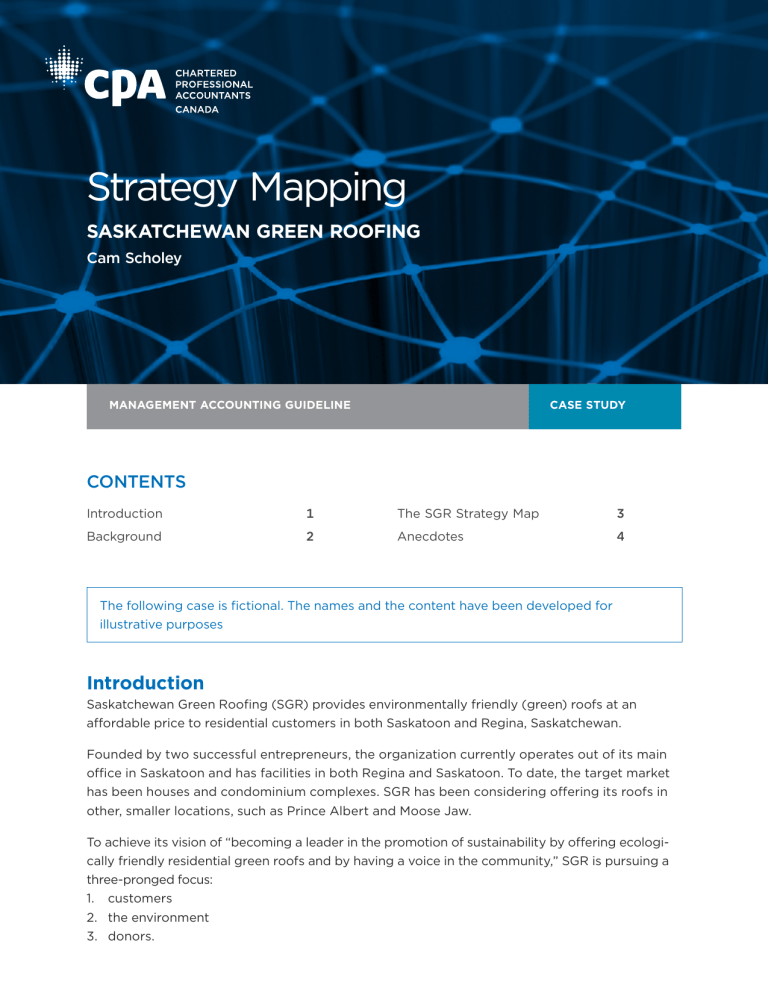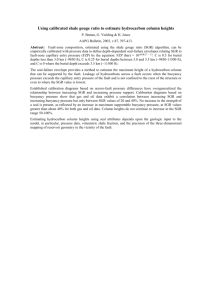
Strategy Mapping SASKATCHEWAN GREEN ROOFING Cam Scholey MANAGEMENT ACCOUNTING GUIDELINE CASE STUDY CONTENTS Introduction 1 The SGR Strategy Map 3 Background 2 Anecdotes 4 The following case is fctional. The names and the content have been developed for illustrative purposes Introduction Saskatchewan Green Roofng (SGR) provides environmentally friendly (green) roofs at an afordable price to residential customers in both Saskatoon and Regina, Saskatchewan. Founded by two successful entrepreneurs, the organization currently operates out of its main ofce in Saskatoon and has facilities in both Regina and Saskatoon. To date, the target market has been houses and condominium complexes. SGR has been considering ofering its roofs in other, smaller locations, such as Prince Albert and Moose Jaw. To achieve its vision of “becoming a leader in the promotion of sustainability by ofering ecologically friendly residential green roofs and by having a voice in the community,” SGR is pursuing a three-pronged focus: 1. customers 2. the environment 3. donors. 2 Background Samantha Christofer and Andrew Bailey met in their frst year at the University of Saskatchewan and had discussed their mutual desire to start a business that focused on the environment. In their fnal year of university, they had undertaken a project on the feasibility of green roofng in Saskatoon. While they had concluded that, at the time, the viability of the initiative was extremely risky given the market size, they had both agreed that green roofng was likely the wave of the future and that there were lucrative opportunities in larger markets, such as Toronto and Vancouver. Christofer and Bailey started a green roofng company and, with hard work and good timing, were able to build a very successful company that they sold in 2009 at an extraordinary yield. Part of the sales agreement was a non-compete clause that forbade Christofer and Bailey from running a similar business in Ontario or British Columbia. After some time of, they agreed to look into the market in their home province of Saskatchewan, untapped mostly because of the smaller population and a climate that prevented the most common green-roof vegetation from fourishing. Environmental awareness had increased immensely in recent years, and many people had been inspired by the province’s frst green roof project, which started in 2008. Despite this, Christofer and Bailey concluded that it was very unlikely they could realize anything even close to the past success they had experienced. The desire did not fade, however, nor did the longing to remain at home in Saskatoon. Always up for a challenge, Christofer and Bailey decided to start a not-for-proft (NFP) organization that focused on residential green roofs. While they initially wanted to focus on both the environment and profts as they had in their frst venture, they later resolved that a venture that made residential green roofng more afordable for homeowners was good for both the environment and the province. Initial research indicated that an NFP with this mandate would be embraced by local and provincial governments, as well as by a sizable portion of the community. Christofer and Bailey decided to “put their hearts before their wallets” — SGR was formed and began operating in April of 2010. Situation By 2011, SGR was struggling with how to formulate and execute a strategy that would help achieve its vision. While both the staf and the board of advisors, which was formed in early 2010, were knowledgeable and energetic individuals, they lacked experience and expertise in this emerging market. Responding to said challenges also demonstrated the need to employ some or all of the drivers of the RAISE philosophy to ensure their resilience, adaptability and innovation in the face of continuous change and disruption. At a meeting in June of 2012, a board member named Kirsten Murray mentioned that she had a friend who consulted in strategy and performance measurement and who had several NFP clients. After a couple of meetings with Murray, Garth Pride agreed to join the board of advisors, starting as a temporary member, in order to become the primary lead and facilitator for the formulation and execution of the 2013 strategy. Pride specialized in strategy mapping, and it was determined that this would be the platform for upcoming strategic endeavours. Management Accounting Guideline Case Study Strategy Mapping 3 Strategy Review In September 2012, the board of advisors met with Pride to formulate and execute a new strategy for the upcoming year. Pride had studied the young organization’s results to date, as well as all other relevant information. He suggested that the 2013 strategy be based on a model of social change in which the SGR staf and board would play two crucial roles: 1. Provide afordable, high-quality residential green roofs in Saskatchewan; and, 2. Infuence various stakeholder groups by communicating the numerous environmental benefts provided by green roofng. Pride felt that, by taking this approach, SGR could achieve both elements of its vision: the promotion of sustainability and the provision of green roofs. After some lively discussions and very minor vicissitudes, the board adopted the approach. Several meetings later, the results looked promising. The SGR Strategy Map With the guidance of the board, SGR produced a strategy map to represent its new growth strategy (Figure 1). It was decided that the map would refect three key themes: an environmental focus, community support, and operational excellence. The board felt that an optimal blend of these three themes would position SGR to work toward its vision and achieve its strategic objectives. The stakeholder perspective and fnancial perspective were placed side by side to refect the reality that, while the primary critical mission of SGR was focused on stakeholders, it also had to realize a steady stream of revenue from roofng customers in order to remain fnancially viable (i.e., SGR could not depend solely on donors and government agencies). The stakeholder perspective acknowledged the combined efort of providing residential green roofs and creating initiatives to build awareness in the community of the importance of environmental issues and how green roofs are part of the solution. The fnancial perspective refected a combination of revenue growth through both donors and customers, and opened up the possibility of generating funds through community-based events such as workshops and dinner talks. It highlighted the focus on fnancial self-sufciency. The internal process perspective was intended to recognize the youth of the organization, and that it was still very much in the development stage. As a result of this reality, SGR defnitely needed to build the right programs. First and foremost was a roofng program that allowed for reasonable prices, while at the same time generating a modest surplus that allowed for long-term sustainability. Second, SGR wanted to focus on an education program that promoted awareness of the growing importance of environmental concerns and what people could do about them (including the purchase of a green roof). SGR also recognized the importance of the need to build a support system to achieve its objectives. Donors and volunteers would be crucial in facilitating the achievement of these objectives, so putting a spotlight on building a system around this fact was a must. The fnal element in the internal process perspective was to achieve operating efciencies that would allow the organization to provide as much as possible with the limited resources available. It was agreed that each important process would be mapped out, and any improvements to cost, time, and quality that could be identifed would be instilled throughout the organization. Fortunately, three of the board members (including Pride) were professional accountants and had experience in process mapping. Management Accounting Guideline Case Study Strategy Mapping 4 FIGURE 1: SASKATCHEWAN GREEN ROOFING STRATEGY MAP THEMES SASKATCHEWAN GREEN ROOFING STRATEGY MAP Environmental Focus Community Support Operational Excellence STAKEHOLDER SATISFACTION INTERNAL PROCESSES RENEWAL An afordable green roofng program designed to maximize the number of houses in Saskatchewan with green roofs Set realistic roofng fees Seek out revenue generating mission-consistent opportunities Maximize fnancial and moral support from donor groups and government agencies TO ACHIEVE OUR STAKEHOLDER OBJECTIVES AND MEET OUR FINANCIAL OBLIGATIONS, WE MUST: Build the right roof program Build the right education program Build the necessary support system Achieve operating efciencies TO CREATE AND MAINTAIN AN ENVIRONMENT CONSISTENT WITH OUR OBJECTIVES, WE WILL: Support development of required competencies Use new technology as an enabler for teaching and program management Promote a culture of knowledge and innovation OTHER OBLIGATIONS VISION A promotional environment that positions SGR as a leader in environmental initiatives that contribute to and support the environment TO ACHIEVE FINANCIAL SELF-SUFFICIENCY, WE: FINANCIAL OBLIGATION TO MEET AND EXCEED THE EXPECTATIONS OF CUSTOMERS, DONORS, AND THE ENVIRONMENT, WE PROVIDE: To become a leader in the promotion of sustainability by offering ecologically friendly residential green roofs, and having a voice in the community Anecdotes Early indication was that both the board and staf had embraced the progressive strategy embodied in the strategy map. The majority liked the idea of running all meetings in the context of how topics afected the strategy map and agreed that it was likely a good way to minimize the of-topic discussions that crept into meetings. The founders were extremely pleased with the early results and excited about the future of SGR — they felt poised for growth and success. Christofer said it best: When we founded SGR, we knew there would be a learning curve because our experience was in commercial roofng. This is not a case of “a roof is a roof.” The strategy mapping process allowed Management Accounting Guideline Case Study Strategy Mapping 5 us to step back and ensure that we were formulating and executing a strategy for the relevant roof type in the appropriate market. In addition, it helped us think through the fact that we need to pay great attention to detail on the awareness side as well, that we can’t get too caught up in just the roofng or we won’t achieve our overall objective. I also love that we run meetings using the map as our platform. Much time and aggravation has been saved by realizing that we are deviating from map-related issues and getting back on topic. This has created far more productive meetings and satisfaction amongst the members. We all feel energized and that we are doing the right things to take SGR to the next level. I wish we had taken this approach before. SGR intended to institute monthly reports and meetings using an approach similar to the board meetings, where key measures and major initiatives that drive the strategy map objectives and results would be front and centre. The approach would be altered to ft the meeting (more operational); in essence, however, it would always come back to the strategy map. The main idea was to be consistent across the organization, with the need for minor diferences acknowledged and put in place. During the strategy map initiative, Pride had introduced the Balanced Scorecard (BSC) as a performance measurement and management tool to the rest of the group. The longer-term intent was to implement a scorecarding process to formally and systematically measure progress toward each strategic objective. Pride agreed to stay on the board if he could head up this initiative and use the BSC to set priorities among initiatives, motivate employees and volunteers, align the board, and solicit the external support necessary to achieve its vision. Taken together, the strategy map and other performance monitoring tactics demonstrated both the resilience and adaptability drivers in the RAISE philosophy and ensuring SGR’s sustainable edge. © 2018 Chartered Professional Accountants of Canada This publication is one in a series on Strategy Mapping. The entire series of overview, guideline, case study 1 and case study 2 are available on our website. For additional information or for general inquiries, please contact us at mags@cpacanada.ca. All rights reserved. This publication is protected by copyright and written permission is required to reproduce, store in a retrieval system or transmit in any form or by any means (electronic, mechanical, photocopying, recording, or otherwise). For information regarding permission, please contact permissions@cpacanada.ca. DISCLAIMER The material contained in this management accounting guideline series is designed to provide illustrative information of the subject matter covered. It does not establish standards or preferred practices. This material has not been considered or acted upon by any senior or technical committees or the board of directors of CPA Canada and does not represent an official opinion or position of CPA Canada. Management Accounting Guideline Case Study Strategy Mapping


